
Cornelis Theodorus Maria 'Kees' van Dongen was a Dutch-French painter who was one of the leading Fauves. Van Dongen's early work was influenced by the Hague School and symbolism and it evolved gradually into a rough pointillist style. From 1905 onwards – when he took part at the controversial 1905 Salon d'Automne exhibition – his style became more and more radical in its use of form and colour. The paintings he made in the period of 1905–1910 are considered by some to be his most important works. The themes of his work from that period are predominantly centered around the nightlife; he paints dancers, singers, masquerades and theatre. Van Dongen gained a reputation for his sensuous – at times garish – portraits of especially women.
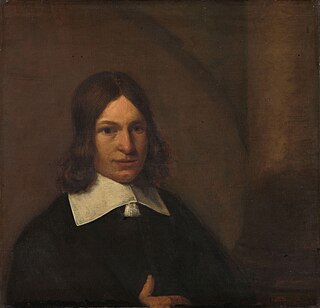
Pieter de Hooch was a Dutch Golden Age painter famous for his genre works of quiet domestic scenes with an open doorway. He was a contemporary of Jan Vermeer in the Delft Guild of St. Luke, with whom his work shares themes and style.

Militia Company of District II under the Command of Captain Frans Banninck Cocq, also known as The Shooting Company of Frans Banning Cocq and Willem van Ruytenburch, but commonly referred to as The Night Watch, is a 1642 painting by Rembrandt van Rijn. It is in the collection of the Amsterdam Museum but is prominently displayed in the Rijksmuseum as the best-known painting in its collection. The Night Watch is one of the most famous Dutch Golden Age paintings.

The Hague School is a group of artists who lived and worked in The Hague between 1860 and 1890. Their work was heavily influenced by the realist painters of the French Barbizon school. The painters of the Hague school generally made use of relatively somber colors, which is why the Hague School is sometimes called the Gray School.
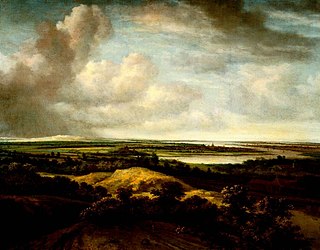
Philip de Koninck, or Philips Koninck (5 November 1619 – 4 October 1688 was a Dutch landscape painter and younger brother of Jacob Koninck.

The Milkmaid, sometimes called The Kitchen Maid, is an oil-on-canvas painting of a "milkmaid", in fact, a domestic kitchen maid, by the Dutch artist Johannes Vermeer. It is now in the Rijksmuseum in Amsterdam, the Netherlands, which regards it as "unquestionably one of the museum's finest attractions".

The Astronomer is a painting finished in about 1668 by the Dutch Golden Age painter Johannes Vermeer. It is in oil on canvas, 51 cm × 45 cm, and is on display at the Louvre, in Paris, France.
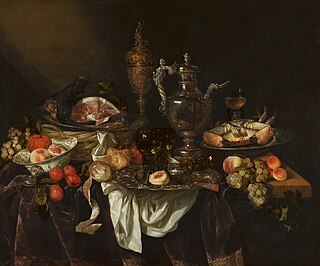
Abraham Hendriksz van Beijeren or Abraham van Beyeren was a Dutch Baroque painter of still lifes. Little recognized in his day and initially active as a marine painter, he is now considered one of the most important painters of still lifes, and in particular still lifes of fish and so-called 'pronkstillevens', i.e. sumptuous still lifes of luxurious objects.

Jan Hendrik Weissenbruch, also known as Hendrik Johannes Weissenbruch was a Dutch painter of the Hague School. He is noted especially for his watercolours.

Willem Kalf was a Dutch Golden Age painter who specialized in still lifes. Later in his life, Kalf became an art dealer and appraiser.

The Kunsthal is an art museum in Rotterdam. It opened in 1992.

The Willem de Kooning Academy is a Dutch academy of media, art, design, leisure and education based in Rotterdam. It was named after one of its most famous alumni, Dutch fine artist Willem de Kooning.

Hendrik van Minderhout was a Dutch-born who was primarily active in the Flemish cities Bruges and Antwerp. He painted .marine paintings, harbor scenes, cityscapes, landscapes and architectural paintings. He also collaborated as a staffage painter with Flemish landscape and perspective painters.

Andreas Schelfhout (1787–1870) was a Dutch painter, etcher and lithographer, known for his landscape paintings.
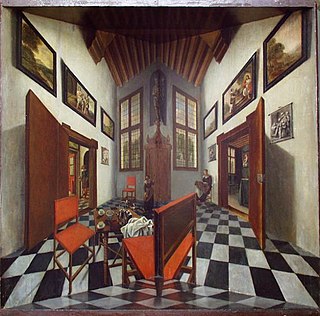
Pieter Janssens Elinga (1623–1682) was a Dutch Golden Age painter, mainly of domestic interior scenes with a strong emphasis on the rectangular geometrical elements of windows, floor tiling paintings, and other elements, and a few genre figures. He also painted still lifes.
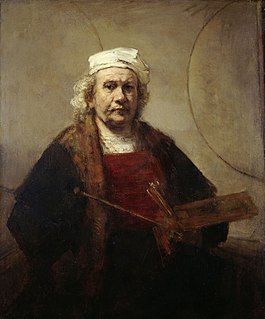
Self-Portrait with Two Circles is an oil on canvas painting by the Dutch artist Rembrandt, painted c. 1665–1669, one of over 40 painted self-portraits by Rembrandt.
Hermanus (Herman) Berserik was a Dutch painter and print maker. He was a member of the Pulchri Studio in The Hague. He studied art at that city's Royal Academy of Art, where his teachers included Willem Schrofer, Willem Jacob Rozendaal, and Rein Draijer.
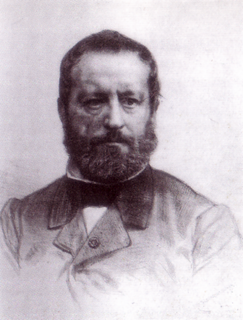
Wouterus Verschuur was a Dutch painter of animal subjects – mainly horses – and of landscapes. He is one of the later representatives of Romanticism in Dutch art.
The Laren School is the name of an art colony located in the Dutch village, Laren, in Het Gooi near Hilversum. The artists of this offshoot of the Hague School chose the inhabitants of Laren and the surrounding landscape as the subject of their art.

Ron van der Ende is a Dutch visual artist, who works as sculptor, installation artist, and video artist. He is known for his monumental bas-reliefs, depicting objects such as cars, buildings and space capsules.


















